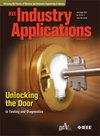Experimental Assessment of Partial Shading Detection in PV Panels Using Impedance Spectroscopy
IF 4.5
2区 工程技术
Q2 ENGINEERING, ELECTRICAL & ELECTRONIC
引用次数: 0
Abstract
This article investigates the use of Impedance Spectroscopy (IS) to identify mismatches in Photovoltaic (PV) panels/string/array, particularly for detecting partial shading effects. The findings confirm IS as a promising tool for on-field applications, especially in small-scale urban power plants where partial shading is a common issue. An analysis of several experimental impedance spectra measured with PV panels operating at their Maximum Power Point (MPP), with controlled partial shading conditions, reveals that partial shading induces a characteristic double-arc deformation. This feature could be leveraged in a diagnostic tool for mismatch detection. The key advantage of this approach is its ability to perform IS measurements at MPP, preserving the normal operating conditions of the PV panels/string/array. Additionally, IS requires minimal modifications to the system's architecture and integrates easily into existing power electronics interfaces. To validate the consistency of impedance spectra under partial shading, experimental data were compared with two models: a Constant Phase Element (CPE) model adapted for PV strings in non-uniform conditions and an enhanced Single-Diode Model (SDM) developed for SPICE3-based simulations. The results confirm that IS successfully adjusts the models and detects mismatches in both experimental and simulated scenarios, demonstrating its scalability and effectiveness as a state-of-the-art PV diagnostic tool.阻抗光谱法在光伏板部分遮阳检测中的实验评估
本文研究了使用阻抗光谱(IS)来识别光伏(PV)板/串/阵列中的不匹配,特别是用于检测部分遮阳效应。研究结果证实了IS是一种很有前途的现场应用工具,特别是在局部遮阳是常见问题的小型城市发电厂。在可控的部分遮阳条件下,对运行在最大功率点(MPP)的光伏板的阻抗谱进行了实验分析,发现部分遮阳引起了典型的双弧变形。可以在诊断工具中利用该特性进行不匹配检测。该方法的主要优点是能够在MPP上执行is测量,保持光伏板/串/阵列的正常运行条件。此外,IS只需要对系统架构进行最小的修改,并且可以轻松集成到现有的电力电子接口中。为了验证部分遮阳条件下阻抗谱的一致性,将实验数据与两种模型进行了比较:一种是适用于非均匀条件下PV串的恒相元(CPE)模型,另一种是基于spice3的增强型单二极管模型(SDM)。结果证实,IS成功地调整了模型,并在实验和模拟场景中检测到不匹配,证明了其作为最先进的光伏诊断工具的可扩展性和有效性。
本文章由计算机程序翻译,如有差异,请以英文原文为准。
求助全文
约1分钟内获得全文
求助全文
来源期刊

IEEE Transactions on Industry Applications
工程技术-工程:电子与电气
CiteScore
9.90
自引率
9.10%
发文量
747
审稿时长
3.3 months
期刊介绍:
The scope of the IEEE Transactions on Industry Applications includes all scope items of the IEEE Industry Applications Society, that is, the advancement of the theory and practice of electrical and electronic engineering in the development, design, manufacture, and application of electrical systems, apparatus, devices, and controls to the processes and equipment of industry and commerce; the promotion of safe, reliable, and economic installations; industry leadership in energy conservation and environmental, health, and safety issues; the creation of voluntary engineering standards and recommended practices; and the professional development of its membership.
 求助内容:
求助内容: 应助结果提醒方式:
应助结果提醒方式:


